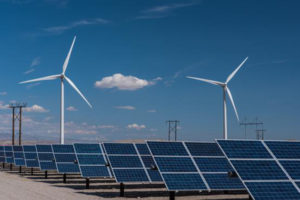 While the performance and durability of batteries and fuel cells have improved in recent years, there are still limits imposed by materials and chemicals that can be used safely, efficiently and cost-effectively.
While the performance and durability of batteries and fuel cells have improved in recent years, there are still limits imposed by materials and chemicals that can be used safely, efficiently and cost-effectively.
Vijay Ramani, an expert in electrochemical engineering and renewable energy integration at Washington University in St. Louis, has received a $2 million grant from the U.S. Department of Energy’s Advanced Research Projects Agency – Energy (ARPA-E) to create a new membrane that can be used in batteries for grid-scale electric energy storage.
Ramani’s team will use inexpensive commercial polymers to create the membrane for redox flow batteries, which are rechargeable batteries that store electricity in chemical solutions during charging and release electricity on demand while discharging. The layered membrane, which the team will make functional with a nanopowder, prevents the chemicals in the two sides of the battery from mixing, which would lead to a chemical short circuit, while enabling ions to flow effectively between the solutions. A key novelty is that this membrane would also allow for different chemical combinations to be used at each electrode of the battery, which increases versatility while lowering costs. Ramani’s lab will primarily investigate cerium, iron and chromium couples in their research.
One advantage of the redox flow battery is that energy and power are effectively decoupled, making them readily scalable. While the flow batteries are yet to be fully deployed at a commercial scale, they have multiple applications, said Ramani, the Roma B. and Raymond H. Wittcoff Professor in the Department of Energy, Environmental & Chemical Engineering in the School of Engineering & Applied Science and the director of the university’s Center for Solar Energy and Energy Storage, within which the project will be performed.
“The primary application would be in-grid integration of intermittent renewables, such as solar photovoltaic (PV) and wind energy,” Ramani said. “Additionally, utility companies could better balance supply and demand by storing electricity in these batteries for times of high demand,” Ramani said. “Moreover, in conjunction with intermittent renewables, such as solar PV and wind energy, developing countries could also use them to partly electrify villages that are not connected to a grid, which would have tremendous societal impact.”
Ramani’s team will create four types of membranes, which are about one-fourth the thickness of a piece of paper. Once they select successful candidates that meet performance and cost targets, they will work with an industrial partner to enable roll-to-roll processing to manufacture industrial scale batteries.
“This is a challenging project with tight cost targets, but it is derived from fundamental research performed in our laboratory, and we have a strong foundation in this domain,” Ramani said.
Ramani received the award from ARPA-E’s Integration and Optimization of Novel Ion Conducting Solids (IONICS) program, which seeks to create innovative components for the next generation of batteries, fuel cells and other electrochemical devices. The agency awarded $37 million in funding for 16 new projects through the program.